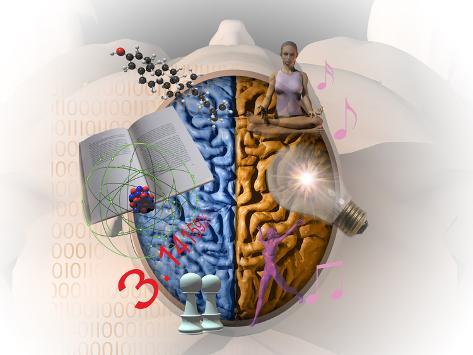Brainwave entrainment or "brainwave synchronization" are methods aimed to induce brainwave frequencies to fall into step with a stimulus with the same frequency. Alpha, theta and delta are slow, and in the slower frequency ranges the right-brain and left-brain communicate better. This would allow both macroscopic "big-picture" and detail-oriented thought processes equal consideration. It can also bring harmony to ideas of logic vs. emotion. When awake and alert, a pure theta state is not possible, but there are ways to get the brainwaves to alpha and theta together both relaxing the brain and turning it on.
Binaural beats or isochronal tones are a highly regarded sonic form of brainwave stimulation. Music with steady beats, especially with layers of pulses will tune brainwaves to theta. This is possible because the brain has a "frequency following" response to aural provocation. There are also visual stimuli that can create specific brainwave response. For instance here are combined audio-visual entrainment video examples on Squareeater - for theta waves I would recommend trying out the Lucid square. Use headphones.
Sensory deprivation tanks, or float tanks, allow for an extended theta state experience. Letting go and exploring a different state of consciousness can be a way to let the mind truly wander, completely withdrawn from sensory input. Up until the age of six our primary mental activity is done in theta which explains flashbacks to early childhood memories occurring while in the float tank. If you opt to try sensory deprivation, take a means of recording your immediate ideas that result as you may not hold onto them for long similar to the difficulty of recalling a dream once awake. In our daily lives we are bombarded with overwhelming sensory agitation so a float tank is the opposite extreme that can help to open the mind to internal instead of external ideas. Of course you cannot actually practice artistic endeavors while in the tank; the benefit you get is the state of serenity and the ideas that you hold onto directly after.
Runner's high or the sense of elation felt during vigorous athletic activity or physical exertion is another way to experience a theta state. Other examples of ways to achieve theta are with self-hypnosis and practiced meditation. Although meditating helps people find long periods of theta, this can take the better part of a lifetime to learn how to accomplish.
With the aid of the theta brainwaves we can break outside of the limitations of the physical senses and expand or shift our perception of reality. Everyone can train their brains to awaken a latent ability and believe in boundless possibilities. In doing so, creative people can surpass their mental blocks and pick up the tools of their trade and materialize something inspired from the realm of the imagination.
To read more about how theta brainwaves affect creativity Click Here.
 |
| Illustration by: Carol & Mike Werner |
Binaural beats or isochronal tones are a highly regarded sonic form of brainwave stimulation. Music with steady beats, especially with layers of pulses will tune brainwaves to theta. This is possible because the brain has a "frequency following" response to aural provocation. There are also visual stimuli that can create specific brainwave response. For instance here are combined audio-visual entrainment video examples on Squareeater - for theta waves I would recommend trying out the Lucid square. Use headphones.
Sensory deprivation tanks, or float tanks, allow for an extended theta state experience. Letting go and exploring a different state of consciousness can be a way to let the mind truly wander, completely withdrawn from sensory input. Up until the age of six our primary mental activity is done in theta which explains flashbacks to early childhood memories occurring while in the float tank. If you opt to try sensory deprivation, take a means of recording your immediate ideas that result as you may not hold onto them for long similar to the difficulty of recalling a dream once awake. In our daily lives we are bombarded with overwhelming sensory agitation so a float tank is the opposite extreme that can help to open the mind to internal instead of external ideas. Of course you cannot actually practice artistic endeavors while in the tank; the benefit you get is the state of serenity and the ideas that you hold onto directly after.
Runner's high or the sense of elation felt during vigorous athletic activity or physical exertion is another way to experience a theta state. Other examples of ways to achieve theta are with self-hypnosis and practiced meditation. Although meditating helps people find long periods of theta, this can take the better part of a lifetime to learn how to accomplish.
 |
| Illustration Showing the Attributes of Left and Right Brain Activity in Humans by Carol & Mike Werner |
With the aid of the theta brainwaves we can break outside of the limitations of the physical senses and expand or shift our perception of reality. Everyone can train their brains to awaken a latent ability and believe in boundless possibilities. In doing so, creative people can surpass their mental blocks and pick up the tools of their trade and materialize something inspired from the realm of the imagination.
To read more about how theta brainwaves affect creativity Click Here.




.png)





0 comments: